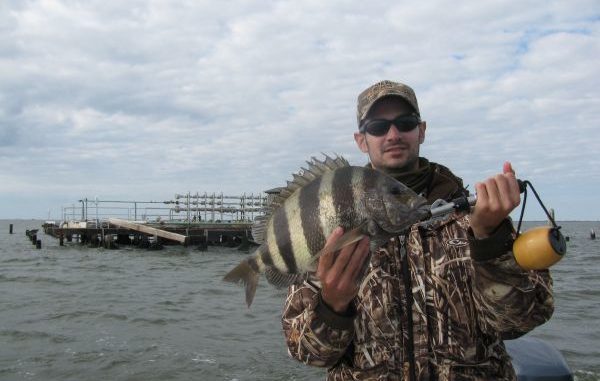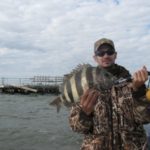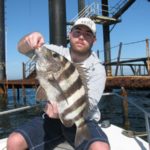
Why struggle to put a few wimpy trout in the boat when legions of sheepshead can be caught at the rigs and well heads just off the coast. Here’s how to catch these renowned bait bandits.
Doc’s spanking-new bay boat, a 24-footer, was primed for its maiden voyage. Doc himself seemed uncharacteristically pumped for the occasion; lately his fishing had seemed more perfunctory than the traditional obsession we all recalled while growing up together.
This period spanned from New Orleans The Times-Picayune’s McFadden Duffy through By HEK through Bob Marshall to Todd Masson. Quite a stretch.
But from the look on his face on this Endymion parade night at his French Quarter bungalow, the anticipation to wet his new boat had gotten Doc’s fishing groove back, almost like during Fat City’s heyday. His face looked like it did the night he won the “dance-contest” at Kenny Vincent’s South Side.
“Hear they’re wearin’ da specks out around Oak River!” he beamed to Pelayo while freshening his drink. “Typical for this time a year. You’re still coming, huh? I need an outboard expert onboard tomorrow. A boat doctor by any other name. If I can’t get Hank Johnston I’ll get Pelayo, I always say!”
Doc always makes sure Pelayo’s with him on the first few trips with any of his mechanical toys — from his Suburban to his four-wheeler to his boats to his houseboat to his various actual homes. Pelayo will listen for any telltale signs of anything malfunctioning or not quite up to snuff, make recommendations, and get it squared away plenty pronto — while it’s still under warranty.
“Artie went to Oak River last week,” Doc announced. “He was wailin’ on the specks! We’ll be wailin’ on ’em tomorrow, too!”
Then he leaned over to his sister-in-law. “Coming, Val?” he asked.
Doc’s sister–in-law Valerie and her husband Sid, as usual, were in from New York for Mardi Gras week. But her face did not exactly reflect Doc’s excitement. Instead she was all frowns. She seemed to have perfected that “fish mouth” so beloved of girls on Facebook nowadays.
“Did you say specks?” she grimaced, while turning to Doc. “Please! Not those skinny little fish with the mushy meat fulla those skinny little white worms! And they barely fight! Kinda like pulling up an oyster shell! I thought we were going fishing for those hard-fighting, big, fat fish with the delicious firm meat, the stripes and the teeth like Jerry Lewis in The Nutty Professor!”
I grabbed Valerie by the arm and jerked her away just in time.
“We are!” I sputtered into her ear, covering it in spit as we huddled behind the kitchen door. “Don’t worry: I promised you and Sid we’d be going on another sheepshead meat haul. And we are! But Doc doesn’t know it just yet.
“Just play along with Pelayo and me. We got it all figured out. Trust me. But don’t mention sheepshead to Doc; just play along like you’re all pumped for specks.”
Val looked up, fish-mouthed again, but finally nodded. “Whatever works,” she shrugged.
Like many nonlocals, Valerie and Sid remain utterly mystified by the Yat-Bogalee-Cajun fetish for speckled trout — especially with so many other better-eating, better-fighting fish swarming in our waters. For a born-and-bred New Orleanian of Doc’s generation, targeting sheepshead on a fishing trip is simply unthinkable. Oh, every now and then he’ll keep one caught incidental to specks or reds, wrap it in cheesecloth and berl it with crabs or crawfish. Then flake off the meat to make mock stuffed crabs or cakes.
But that’s about it. The notion of putting those thick, white fillets in a cast-iron griddle covered in the same butter/lemon/Parmesan sauce Drago’s invented for grilling oysters and putting them over the grill or under the broiler until they bubble and brown — speaking of which:
“Whooo-boy! Here it comes!” Artie announced from the kitchen.
And the entire room, including the balcony crowd, was soon hovering around the kitchen table, dipping French bread, scooping with forks and yumming away.
“We told Doc these were redfish fillets!” Artie snickered. “But they’re the sheepshead we caught last week.”
On other occasions we fry, blacken, bronze, bake or broil sheepshead fillets. Thin cutting and flash frying works particularly well with sheepshead. The same low oil content that makes the meat hold up exceptionally well to freezing makes it a bit dry if over-fried. So it’s best to deep fry sheepshead chunks or strips or chips about two-thirds as long as you might fry speck fillets.
As the Times Picayune Creole cook book (circa 1911) boasted: “Sheepshead is perhaps the Gulf fish most to be commended for frequent household use, being susceptible of a far greater variety of modes of preparation than any other fish. It is good in any form: broiled, baked, fried or boiled.”
But that was a century ago. Such notions just don’t seem to click with modern-day Louisianans, the supposed culinary masters of the universe. My guess is the popularity of electric filleting knives did much to tarnish the sheepshead in trendy fishing circles.
Indeed, it was only about a decade ago that the delectable drum that swarm in Louisiana’s coastal waters graduated from “trash fish” to “respectable.” And nowadays swanky restaurants boast “puppy drum” as “catch of the day!”
As usual, there’s no accounting for taste (especially in South Louisiana).
“Man, ya see me? I don’t foooool widem!” was a traditional quip for most Louisianans of Doc’s generation. “I trow dem drum back — and dem sheepshead, too! Dey ain’t no good!”
In fact, though many people equate the two, black drum and sheepshead have little in common — except stripes and delectable, firm, white meat. They’re not even close relatives. A drum is more closely related to a speck than to a sheepshead, which is actually a big pinfish, a member of the porgy family.
Five people casting for an hour in the Pencil Canal/ Oak River area produced seven feeble-fighting winter specks, none over 13 inches.
Valerie and Sid were not impressed. They kept looking over at Pelayo with an “I-told-you-so” frown. They’d been through this a few times before, prior to our introducing them to our now-traditional Mari-Gras sheepshead meat hauls.
But Pelayo kept winking at them and putting his fingers to his lips in the universal “shuuuush — be nice” signal, hinting that such a meat haul was still in the offing.
Over to the Twin Pipeline/Oak River intersection, another three baby specks, and Valerie and Sid put their poles down, and huddled on the bench seat behind the console, rolling their eyes whenever we looked at them.
Doc, on the other hand, kept casting and retrieving, slowly walking his jig over the bottom.
“You wanna slow down your retrieve a bit in late winter,” he said, while looking around at his near-comatose fishing guests. “Dem trout are sluggish this time a year.”
The trout weren’t the only creatures “sluggish” this morning.
“Let’s head out a little farther, Doc,” Pelayo suggested while lifting up the trolling motor. “I heard some good reports from out by Bay Gardene.”
“Bay Gardene?” Doc frowned. “But that’s later, springtime fishing. Ain’t never heard of specks in that area in February. But OK — we’ll give it a try.”
Pelayo nodded, winked and nudged Valerie in the ribs as he put his rod in the holder.
Casting around the islands in Bay Gardene produced nothing (no surprise), but now the rigs known on maps as the West Black Bay Oil and Gas Field and as Stone Island by most of this area’s fishermen were a stone’s throw away.
“Hey Doc!” I laughed. “Whaddaya say we give Stone Island a try? Heck we’re practically already there?”
“Stone Island?” Doc grimaced. “It’s February, man! Give it another two months, then maybe we’ll try it.”
“Come on, Doc,” Pelayo needled. “We need fish for the Mardi-Gras-day bash. Your in-laws expect it. They didn’t come down here to eat hamburgers and ribs, for crying out loud! They can get that at home.”
So after another 20 minutes of fruitless casting, Doc finally relented. After a short haul over a calm Black Bay, we were tying up to the big platform just southeast of what’s left of Stone Island.
I’d stashed 2 pounds of fresh shrimp in a little cooler.
“No dead shrimp on my new boat!” Doc had declared earlier. So I smuggled them aboard inside an elegant little cooler. Doc’s “gag gift” for “the man who has everything” was now revealed as anything but a gag.
I pulled out his electric hook sharpener and started methodically sharpening the hooks on about a dozen ½-ounce jigheads I planned to use.
This got a big laugh from everyone on board. But for someone intent on filling a “box” with delicious sheepshead, this was no laughing matter. A sheepshead’s mouth is not like a specks, or even a reds — much less a sac-a-lait’s. It’s hard and bony. A super-sharp hook really helps the vital hook-setting process.
You feel those taps — he takes it for good and the rod tip dips — wham! You jerk up and the battle’s on!
With a sharp hook that’s all it usually takes.
Doc started casting his baitless plastic cocahoe around the legs as if he were speck fishing in May, while I baited up Valerie’s jighead — along with mine — with shrimp and we cast near the platform’s legs, actually hitting them.
It took all of 30 seconds for Valerie to start shrieking, her face in half-laugh and half-grimace mode as she grabbed the medium spinning rod a foot above the reel and cranked away spastically.
Sid quickly moved in to help with the task of muscling up her fish.
Pelayo’s shrimp-tipped jighead plinked against the rig’s piling, hit the water and sank no more than 10 feet. Pelayo nodded his head as if counting off the seconds. He got to 25 and — wham! He reared back and set the hook.
“Here’s your finicky bait-stealer, Sid!” he said.
Those extra sharp hooks were doing their thing.
Sid, who was still helping Maria muscle in her “Bay Snapper,” had read up on sheepshead in an “authoritative fishing guide.” He read about the “striped bandit” named for its “uncanny skill in stealing bait,” how only the most “skillful anglers” with the “deftest touch” managed to catch these “shy and wily fish” — and then only by employing “live fiddler crabs” as bait and remaining ever alert to the slightest tapping.
What a joke — for Louisiana fishermen that is.
“Notice my delicate angling skill and deft touch!” I howled from the bow while setting the hook on another sheepshead 20 second after casting.
With 10 sheepshead in the box, Doc finally relented, started tipping with shrimp and whooping right along with the rest of us.
“Can’t beat em?” he shrugged. “Join em!”
The boy knew he’d been conned into coming out here — but remained a good sport about our ruse.
There really is nothing to this type of fishing. A “slaughter pole” would work as well. In fact, that’s exactly what some commercial fishermen now use in the shallow West Delta rigs, swinging them aboard one after another during late winter and spring.
‘Here, swing it over,” I said.
I tipped Valerie’s jig with another a chunk of shrimp. She dropped it over the side close to a piling, let it drop about 6 feet and flipped the bail. The rest of us chunked our fish in the box and rebaited our plain ¼-ounce jigheads.
Current was slack and, thus, nothing heavier was needed to keep the bait near the pilings. Often the key in this type of fishing is to keep the bait as close as possible to the piling. With a strong current this is often easier a mere 4 or 5 feet from the surface and amounts to a saltwater version of cane-pole perch-jerking or sac-a-lait jigging around stumps.
In seconds Pelayo grabbed the leader and swung another chunky sheepshead aboard. Then he cast away from the rig, let his bait hit the bottom, cranked the reel a couple of times — and pulled out a gorgeous puppy drum.
No time for landing nets with this type of fishing. We like 30-pound mono or fluorocarbon shock leaders about 3 feet long atop the jigs so we can reach down and swing these heavy fish aboard — one after another.
I was just flipping the bail after adding more ice to the box when — wham! The battle was again joined. The fish hit the shrimp-tipped jig not 5 feet from the surface, but my drag was loose so he started stripping out line like a maniac.
Such stuff went on for a couple hours, with five fishermen participating. We fished one rig and two well jackets till Doc’s 110-quart cooler was filled to capacity.
Say you’re having a slow day up around the Hopedale Rocks this time of year? Well similar rigs are accessible just off the coast in that area.
Say you are having a tough time locating clear water and specks in the Buras/ Venice area? Well, the Sandy Point rigs (the West Delta 20 blocks) beckon right off the coast not two miles out.
Say you are futilely fishing near the surf or in the back bays around Grand Isle/Fourchon? Well, those rigs right off the beach are as crammed with ravenous spawning sheepshead as are all others off our coast this time of year.
You’ll find them swarming around most structures from 15- to 50-foot depths all along our coast during the spawn.
So there’s simply no reason to go home skunked. And there’s no reason to let your out-of-town friends and relatives go home with a few dinky sandwich bags of mushy, parasite-ridden little fillets instead of bulging gallon bags of thick, white, delicious sheepshead fillets.




